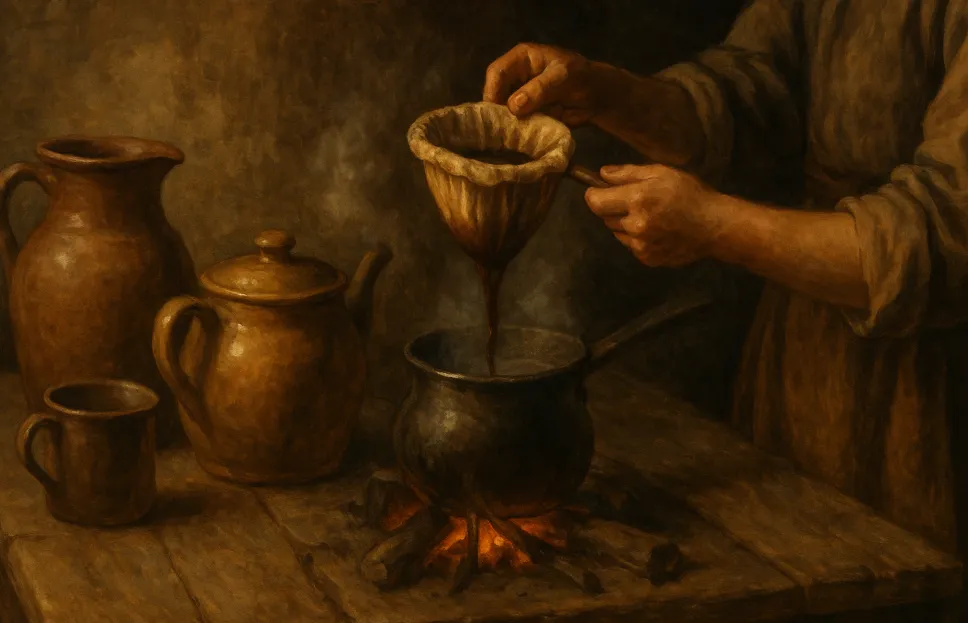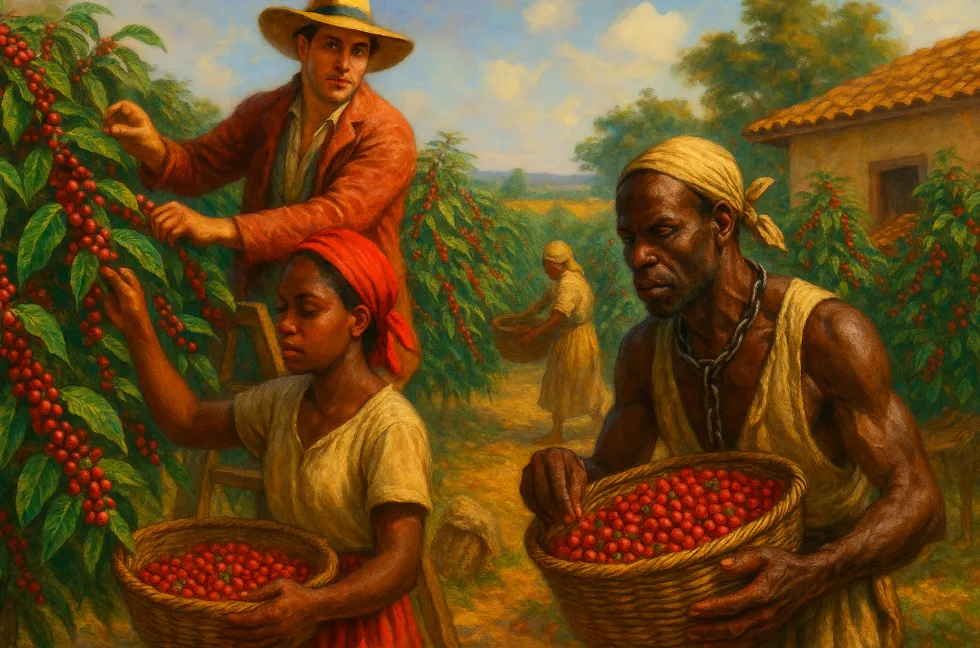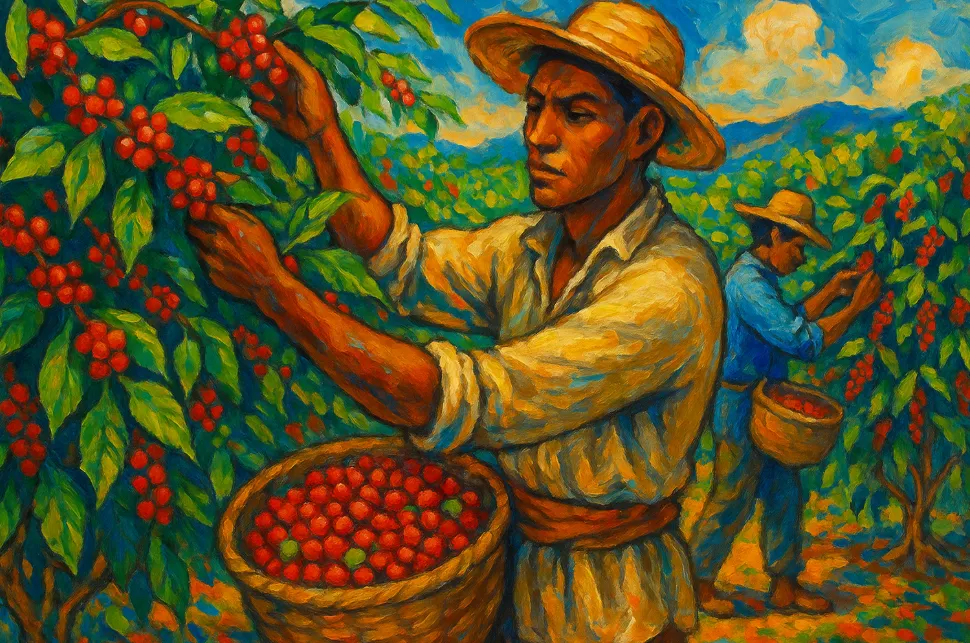Early Coffee Brewing Tools: Cloth Filters, Simple Pots & Ancient Techniques
Discover pre-industrial coffee brewing methods including cloth filter coffee, simple pot brewing, and direct immersion techniques. Learn how ancient coffee preparation tools laid the foundation for modern brewing innovations.
- Coffee Basics Nerds
- 6 min read

Early Coffee Brewing Tools: From Cloth Filters to Simple Pots
Before paper filters and sophisticated brewing equipment, coffee enthusiasts relied on ingenious early coffee preparation methods using readily available materials. These traditional coffee tools - from cloth filtration systems to simple pots for direct immersion brewing - established the fundamental principles that guide modern coffee brewing today.
Building on the ancient mortar and pestle and Turkish ibrik methods, let’s explore how coffee brewing evolved through practical innovations that made better coffee accessible to more people.

The Revolution of Cloth Filter Coffee
Cloth filter coffee represented a major advancement in coffee clarity and consistency. This innovation marked the first systematic attempt to separate coffee grounds from the finished beverage, creating a cleaner cup than previous methods.

The Science Behind Cloth Filtration
Why cloth filters worked:
- Porous structure: Natural fiber weave allowed liquid through while trapping grounds
- Larger pore size: Permitted coffee oils to pass through, maintaining flavor complexity
- Gravity assist: Used natural forces for separation without mechanical intervention
- Reusable design: Could be cleaned and used repeatedly, making it economical
Materials Used for Coffee Cloth Filters
Traditional cloth filter materials:
- Linen: Most popular choice for its durability and fine weave
- Muslin: Lighter alternative offering different filtration characteristics
- Cotton: Regional availability made this a common substitute
- Hemp: Sturdy option in areas where hemp cultivation was common
Each material produced slightly different filtration results, affecting both clarity and flavor profile.
The Cloth Filter Brewing Process
Step-by-step traditional method:
- Cloth preparation: Clean, damp cloth positioned over brewing vessel
- Coffee placement: Coarsely ground coffee placed in cloth “pouch”
- Water heating: Water heated to appropriate temperature (usually boiling)
- Pour-over technique: Hot water poured slowly over coffee in cloth
- Gravity extraction: Brewed coffee filtered through cloth into collection vessel
- Serving: Clear coffee served while grounds remained in cloth
Regional Variations in Cloth Filtering
Different cultures developed unique cloth coffee filter approaches:
European Method:
- Suspended cloth over wide-mouth vessels
- Multiple small pours for even extraction
- Focus on clarity and consistency
Middle Eastern Adaptation:
- Smaller cloth portions for concentrated brewing
- Integration with existing coffee rituals
- Emphasis on strong, full-bodied results
Asian Innovations:
- Fine silk cloths for ultra-smooth filtration
- Ceremonial aspects incorporated into brewing process
- Regional spice additions during filtration
Simple Coffee Pots: Direct Immersion Brewing
Simple coffee pots history shows how basic vessels evolved to optimize coffee extraction through direct contact between water and grounds.

Materials and Construction
Common pot materials:
- Clay/Ceramic: Excellent heat retention and neutral flavor impact
- Copper: Superior heat conduction for even temperature distribution
- Brass: Durable alternative with good thermal properties
- Iron: Regional availability made this practical despite weight
Direct Immersion Techniques
The basic process:
- Cold start: Coffee grounds added to cold water in pot
- Gradual heating: Slow temperature increase for controlled extraction
- Steeping time: Grounds remained in contact with water throughout brewing
- Settling period: Heat removed, allowing grounds to settle naturally
- Careful serving: Top portion poured while avoiding sediment
Advantages of Simple Pot Brewing
- Full extraction: Extended contact time maximized flavor development
- Temperature control: Pot material helped maintain optimal brewing temperature
- Simplicity: Minimal equipment required for effective brewing
- Strength adjustment: Easy to modify coffee-to-water ratios
- Cost effective: Accessible to people of all economic levels
Comparing Early Filtration Methods
| Method | Clarity | Body | Flavor Notes | Maintenance |
|---|---|---|---|---|
| Cloth Filter | High | Medium | Clean, bright | Regular washing |
| Simple Pot | Low | Heavy | Full, rich | Basic cleaning |
| Turkish Ibrik | Very Low | Thick | Intense, concentrated | Moderate care |
| Mortar/Pestle | Low | Heavy | Rustic, variable | Minimal |
Evolution of Brewing Equipment
From Cloth to Paper Filters
Cloth coffee filter history directly influenced paper filter development:
- 1908: Melitta Bentz invented paper filters, inspired by cloth methods
- Improved convenience: Disposable filters eliminated cleaning requirements
- Consistent results: Standardized filtration reduced variable results
- Widespread adoption: Mass production made paper filters globally accessible
Modern Applications of Traditional Methods
Contemporary coffee enthusiasts rediscovering traditional coffee tools benefits:
Cloth Filter Revival:
- Enhanced flavor: Coffee oils preserved for richer taste
- Environmental benefits: Reusable filters reduce waste
- Artisanal appeal: Hand-crafted quality attracts specialty coffee drinkers
- Cultural connection: Links to historical brewing traditions
Simple Pot Techniques:
- French Press ancestry: Direct immersion principles carried forward
- Camping coffee: Simple pot methods ideal for outdoor brewing
- Cultural preservation: Traditional methods maintained in various regions
Regional Innovations and Adaptations
European Innovations
Northern Europe:
- Larger cloth filters: Accommodating communal coffee consumption
- Metal pot integration: Combining copper pots with cloth filtration
- Seasonal adaptations: Different techniques for varying weather conditions
Mediterranean Region:
- Ceramic pot preferences: Clay vessels favored for heat retention
- Social brewing: Larger vessels for group consumption
- Spice integration: Brewing methods accommodating added flavors
Asian Developments
Southeast Asian Cloth Methods:
- Sock filters: Cloth shaped into sock-like form for easy handling
- Sweet coffee adaptation: Methods accommodating condensed milk additions
- Street vendor techniques: Portable cloth filtering systems
Middle Eastern Refinements
- Precision pouring: Careful water application techniques
- Temperature mastery: Optimal heat control for different pot materials
- Social ceremony: Brewing methods integrated into hospitality rituals
The Science Behind Early Brewing Success
Extraction Principles
Early brewing tools succeeded because they understood fundamental extraction science:
- Contact time: Longer steeping extracted more compounds
- Surface area: Grinding exposed more coffee to water interaction
- Temperature control: Hot water extracted flavors more effectively
- Filtration balance: Removing grounds while preserving desirable compounds
Why These Methods Worked
- Simplicity: Fewer variables meant more predictable results
- Flexibility: Methods easily adapted to different coffee types and preferences
- Accessibility: Used commonly available materials and tools
- Effectiveness: Produced satisfying coffee despite technological limitations
Modern Lessons from Traditional Tools
Brewing Principles That Endure
Early coffee preparation established principles still relevant today:
- Grind size matters: Coarser grinds worked better with longer extraction times
- Water quality important: Clean water essential for good coffee
- Temperature control crucial: Heat management affected final flavor
- Patience pays: Slow, careful brewing produced better results
Contemporary Applications
Modern coffee enthusiasts can learn from traditional coffee tools:
- Cloth filter coffee offers unique flavor profiles unavailable with paper
- Simple pot brewing teaches extraction timing and temperature control
- Historical methods provide perspective on coffee’s essential elements
- Cultural techniques offer alternatives to industrial brewing approaches
The Bridge to Modern Coffee
Understanding early brewing tools cloth filtration simple pots history helps appreciate how far coffee brewing has evolved while recognizing the timeless principles underlying all great coffee preparation.
These ancient coffee brewing tools demonstrate human ingenuity in maximizing flavor extraction using available resources. Whether using a simple cloth filter or basic ceramic pot, our ancestors established the foundation for every modern brewing innovation.
From these humble beginnings, coffee brewing evolved through coffee house culture and colonial expansion to become the sophisticated industry we know today.
The journey from cloth and clay to precision machinery shows how core brewing principles remain constant even as technology advances.
Continue exploring coffee’s fascinating evolution with our guides to how coffee houses shaped society and colonialism’s impact on global coffee production.
You might also like:
- Tags:
- Cloth Filter Coffee
- Early Coffee Preparation
- Traditional Coffee Tools
- Simple Coffee Pots History
- Cloth Coffee Filter History
- Ancient Coffee Brewing Tools
- Pre-Paper Filter Coffee
- Coffee Brewing Evolution
- Specialty Coffee
- Grind Size
- Flavor Profile
- Coffee Water
- French Press
- Hot Water
- Brewed Coffee
- Coffee Brewing
- Ground Coffee
- Coffee Grounds
- Coffee Production
- Paper Filters
- Filter Coffee
- Flavor Profiles
- Flavor Complexity
- Brewing Methods
- Temperature Control
- Coffee Oils
- Global Coffee
- Coffee Extraction
- Flavor Development
- Filter Brewing
- Water Quality
- Clean Water
- Flavor Impact
- Paper Filter
- Step Step
- Flavor Notes
- Modern Coffee
- Cloth Filters
- Clean Bright
- Condensed Milk
- Surface Area
- Clarity Body
- Coffee Consumption
- Coffee Houses
- Brewing Equipment
- Coffee Drinkers
- Middle Eastern
- Cold Water
- Clarity Consistency
- Immersion Brewing
- Cost Effective
- Water Grounds
- Coffee House
- Traditional Method
- Consistent Results
- Grounds Settle
- Cleaner Cup
- Pot Brewing
- Coffee Preparation
- Clarity Flavor
- Heat Management
- Coarser Grinds
- Traditional Methods
- Body Flavor
- Advantages Simple
- Coffee Understanding
- Brewing Process
- Heat Control
- Coffee Fascinating
- House Culture